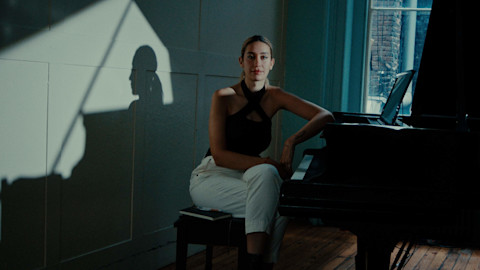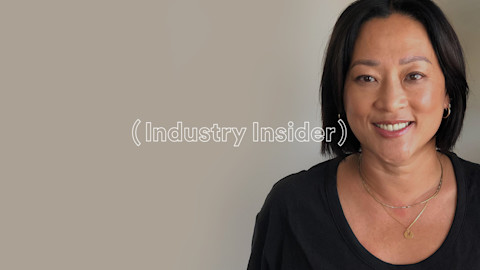The Minnesota violinist shares some thoughts on an overlooked element of the industry.
Accessibility is one of the most overlooked issues in the music industry, from touring with a disability to discussions about inclusivity. About 15% of the global population, or around a billion people live with some form of disability, and disabled artists and music lovers often find themselves without the access they need at music venues and events. While conversations around accessibility continue to get louder, there’s still a lot of work to be done to get to a point where everyone can enjoy a live music experience or feel included in the industry or their music communities.
Gaelynn Lea is a songwriter, violinist, and public speaker from Minnesota who was born with Osteogenesis Imperfecta (also known as brittle bones disease). She’s been in a wheelchair since she was a toddler, has experienced the difficulties of touring with a disability firsthand, and has more than a few things to say about it—she’s currently writing a memoir about disability advocacy and her time playing around the world. She asked us to imagine how quickly change might happen if all artists—not only those with a disability—demanded equal accessibility in the music industry. Here’s how you can help.
Gaelynn Lea Photo Courtesy of EvrGlo Media
Venue accessibility.
The biggest barriers to accessibility on the road and in the industry, Lea says, exist in venues. In the U.S., where the Americans with Disabilities Act (ADA) requires venues, by law, to be accessible, issues still remain. In other countries where those laws aren’t in place, it’s an even bigger issue.
“The biggest barriers that way are bathrooms and entrances, but then as a performer, the additional barrier becomes the stage,” Lea says. “That's the most obvious one.”
Accessibility to entrances and stages can often be fixed by a portable ramp, so requesting ahead of time that a venue have one on hand for a show is one way to make sure your show is available to people with disabilities.
Of course, there are many different kinds of disabilities. For deaf music fans, ASL interpreters provide a way to experience a show more fully. They can be costly, but if you have the resources, an ASL interpreter can add an entirely new dimension to the live experience.
Finally, Lea says the biggest thing artists can do to ensure the venues they play are accessible is to include accessibility information in all of their promotion for the show.
“If it is accessible, make sure people know,” Lea says. “And if you want to be going above and beyond, like providing lyrics sheets or special seating for people—which would be a cool thing for people with chronic illness that can't stand—just say, 'If you need any accommodations, just email this address.' And then try to deal with the requests that you might get. There probably aren't going to be a million, but if somebody can come because you put the word out that you're willing to accommodate, that's even better.”
Life on the road.
There are more subtle barriers to equal accessibility. While many artists think of the touring life as driving for hours a day and crashing on floors, that’s not really an option for artists with mobility issues. Lea says that it would be a dream to have a network that provides artists with accessible places to stay, but until that idea gets turned into an app (do it!), maybe reach out to the local venues you’re friendly with and let them know if you’re able to provide an accessible place to stay for other artists touring through your town.
“The reality is that it's harder for me to tour right now than it is for some person who's not thinking about accessibility, but it won't get better,” Lea says. “It wouldn't take that long if people were a little more engaged in the issue as a collective, if all the artists cared about it. I don't think it would take as long as it's going to take if It's just me and any other artists with disabilities. So it's really committing yourself for a bigger reason than just a technicality of accessibility. It's committing yourself because you care about human rights and all citizens deserve access.”
Where can I get on board? How can I get involved further?
Lea says that educating yourself, as well as diversifying the news you read and the people you follow on social media can help deepen your understanding of disability rights and broaden the conversation. All of that increases your ability to be an advocate in all arenas, which will logically extend to things like increased representation on industry panels and day-to-day awareness of the human rights issues that affect disabled people.
“Think of disability as diversity,” Lea says. “Anytime you're planning an event where you have panelists or a bunch of teachers, just try to think about disability being represented in the group you're working with, and if it's not being represented, try to find qualified people who can help expand the dialogue.”
Lea adds that there are some organizations that can help you brush up on the issues facing people with disabilities specifically in the arts realm. Attitude is Everything, based in the UK, is a disability-led charity committed to improving deaf and disabled people’s access to live music that just recently launched a program to learn about the access barriers of disabled artists, and in the US there’s the VSA, an international organization on arts and disability.
“The problem with disability is that I just don't think there's any education that has really sunk into the mass consciousness yet,” Lea says. “I think a lot of us are a little more aware of gender politics, racism, women's rights, and civil rights. We have some basic understanding, but it doesn't mean we know everything, and we definitely have room to get better in all those areas. But the idea of disability isn't really on the radar in a meaningful way. If you read the history, you would get super fired up.”
What does a fully accessible music industry look like?
A fully accessible music industry, Lea says, is about more than just removing barriers. “It's recognizing that all different groups, including people with disabilities, have something to actually offer society culturally.”
What exactly does that mean? Firstly, it’s a music industry that considers all types of disabilities. On a broader scale, it makes a point to include disability as diversity in all areas, such as radio play, who’s being written about in the music media, who record labels are working with, and booking agents who are up to the task of booking tours for disabled performers. As an artist, you have some power here—you can talk to your label about diversifying their roster, drop names during interviews, and ask your booking agent to book you only in accessible venues.
And to expand the sentiment even further, it’s important to embrace the disability community as essential to the cultural dialogue, Lea says, as opposed to including it in events for diversity’s sake: “Seeing it as, 'If we include them, look at all the awesome things that have happened because of the disability community, and celebrating it rather than just including it by default.”
The impact.
Before Lea started performing, she had never seen an artist with a visible disability on stage. When she saw Wheelchair Sports Camp—the moniker of hip-hop artist Kalyn Heffernan—it filled her with pride. “Not that we're all the same,” Lea says, “but you realize, 'Somebody like me, who's gone through a lot of the same experiences to me, is up there doing their thing,’ and it's really empowering to watch.”
As an artist, you’re in a special position to improve things for the next group of artists who will broaden the cultural dialogue. The impact on young people that seeing others like them in empowered creative roles can go a long way toward building better music communities. So—book disabled artists, be a cheerleader for their work, and encourage your communities and teams to get on board.
“I've played shows where afterwards people have said, 'You know, in all my years I've realized I've ever seen anyone who looked like me on stage and it's just so cool to see,’” Lea says. “It's a joyful thing. And in some ways I want to do it even more for the next generation. I see little kids with disabilities at my shows and I just want them to be able to do what I'm doing without all the headache. It is—I’m not going to lie—a lot harder right now and it shouldn't be that hard. I want them to know: 'I can do that.’”
For more tips on how to be an advocate for people with disabilities, check out Gaelynn’s website.
-Matt Williams
Popular Stories
video
How Julia Wolf Made It




